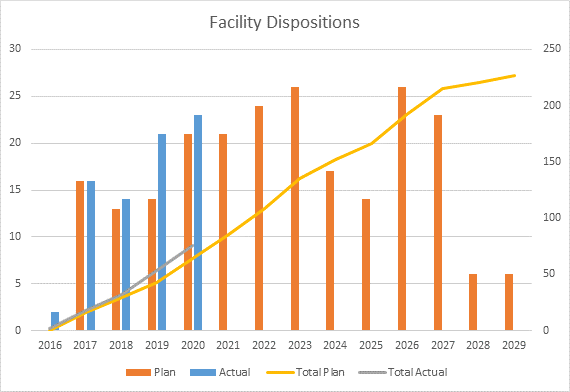
Demolition of Building 9720 22 at Y 12
More than ever before, the landscape of Pantex and Y-12 is changing. In FY 2020 alone, 46 infrastructure projects were completed, and an impressive 21 facilities (11 at Pantex and 10 at Y-12) were demolished.
Diane McDaniel, senior director for Excess Facilities Disposition, has challenged the disposition team with a stretch goal to achieve 100 total demolitions within the years of FY 2015 and FY 2021.
“The disposition team is made up of approximately 50 individual contributors representing all organizations at Y-12 and Pantex. These team members, along with an outstanding subcontractor community and the NNSA Production Office, are the key to the program’s success. Because of their dedication and focus, the CNS disposition program is held up as the example for the other NNSA sites across the country,” McDaniel said.
CNS teams worked diligently to meet their FY 2020 goals during the COVID-019 mission critical operations so that they would be ready to hit the ground running to accomplish as much as possible within the safety envelope when they returned to the site.

“We have never attempted, much less achieved, that many dispositions and square footage of almost 30,000 square feet this year at Pantex,” said Pantex Excess Facility Disposition Program Manager Jennifer Simms. “We continue to achieve more facilities and square feet every single year. We are really ramping up and changing the landscape of the site one demo at a time.”
“Demolitions are important to reduce the site footprint and eliminate facilities that present significant hazards. We have to remove the old to make way for new mission essential facilities,” said Y-12 Excess Facility Disposition Program Manager Kevin Bradford.
“Because we are reducing the footprint with demos, it gives us the opportunity to work with NNSA to obtain the funding needed for new facilities,” said Laura Fox, Pantex Projects Management. “These new facilities will provide greatly improved working conditions for our personnel, as well as provide greater reliability of facility systems.”
Planning for demolition starts no less than two years before the building is actually torn down. Many times, characterization of hazards within and around the facility, location and condition of utilities, and other factors must be known ahead of even starting the drawings that must be produced and provided to contractors for bid.
“Taking down old facilities is always challenging,” Fox said. “Many times, the drawings from when these facilities were constructed are either not available or are unreliable.”
She said it is truly a team effort between organizations including Projects, Procurement, Engineering, Construction Management, and the contractor who work hand in hand to overcome issues and get these buildings down.
New behind the scenes challenges for FY 2021 demolitions are already being reviewed for another 21 planned demolitions next year and more than 25 in FY 2023.